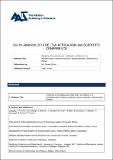| dc.contributor.author | James Akoko, R Pelle, E Schelling, G Shirima, C Mathew, E Fevre, B Bett, E Machuka, J Halliday, R Kazwala, B Bonfoh, C Ouma | |
| dc.date.accessioned | 2020-07-17T11:36:47Z | |
| dc.date.available | 2020-07-17T11:36:47Z | |
| dc.date.issued | 2019-08-05 | |
| dc.identifier.uri | https://repository.maseno.ac.ke/handle/123456789/1520 | |
| dc.description | Objective: Brucellosis is a debilitating zoonotic disease affecting humans and animals with high prevalence in Kenya and Tanzania. This study was conducted to detect and identify the Brucella species circulating in various susceptible livestock hosts in Kenya and Tanzania
Method: Mixed livestock herds (n= 72), cattle (n= 5), sheep (n= 1), goats (n= 1) and camels (n= 15) with suspected cases of brucellosis were identified for blood, milk and abortion material sampling. Genomic DNA was extracted using Qiagen blood and tissue DNA extraction kit. Real-time PCR, was used to detect and identify Brucella species.
Results: Most sampled herds had mixed livestock (80%). Brucella spp. was detected in 54 out of 72 samples that were sequenced. A total of 113 out of 800 samples tested positive on the genus-specific real-time PCR. We found B. abortus to be the most dominant species, accounting for up to 80% of all cases, B. melitensis 5%. On average, in 9% of samples both B. meltensis and B. abortus was detected while 6% were not classified as either B. abortus or B. melitensis.
Conclusion: The detection of zoonotic species of Brucella in all the major livestock present a serious public health risk. The co-infection detected could be as a result of close interaction between different animal species. | en_US |
| dc.description.abstract | Objective: Brucellosis is a debilitating zoonotic disease affecting humans and animals with high prevalence in Kenya and Tanzania. This study was conducted to detect and identify the Brucella species circulating in various susceptible livestock hosts in Kenya and Tanzania
Method: Mixed livestock herds (n=72), cattle (n=5), sheep (n=1), goats (n=1) and camels (n=15) with suspected cases of brucellosis were identified for blood, milk and abortion material sampling. Genomic DNA was extracted using Qiagen blood and tissue DNA extraction kit. Real-time PCR, was used to detect and identify Brucella species.
Results: Most sampled herds had mixed livestock (80%). Brucella spp. was detected in 54 out of 72 samples that were sequenced. A total of 113 out of 800 samples tested positive on the genus-specific real-time PCR. We found B. abortus to be the most dominant species, accounting for up to 80% of all cases, B. melitensis 5%. On average, in 9% of samples both B. meltensis and B. abortus was detected while 6% were not classified as either B. abortus or B. melitensis.
Conclusion: The detection of zoonotic species of Brucella in all the major livestock present a serious public health risk. The co-infection detected could be as a result of close interaction between different animal species. | en_US |
| dc.publisher | AAS Open Res | en_US |
| dc.subject | Brucellosis, livestock production system | en_US |
| dc.title | Diversity of brucellosis and multi-strain co-infection in a transboundary livestock production system between Tanzania and Kenya | en_US |
| dc.type | Article | en_US |

